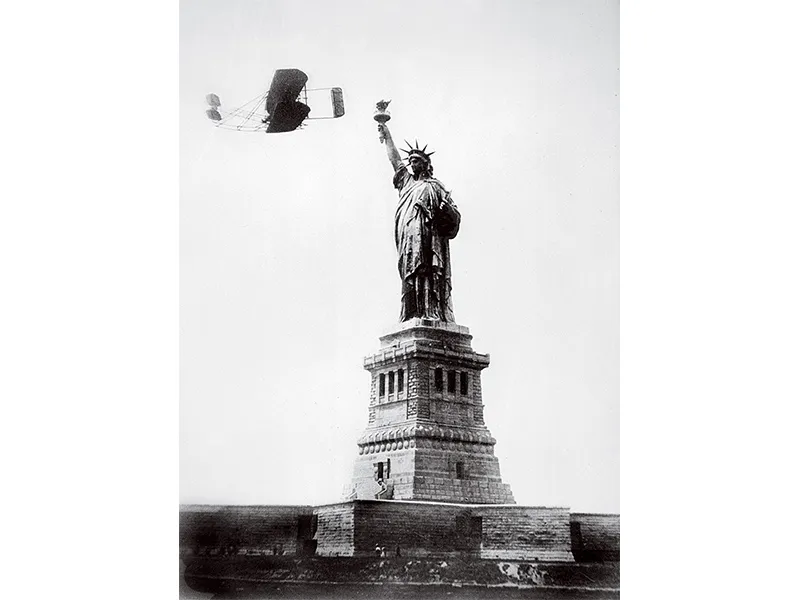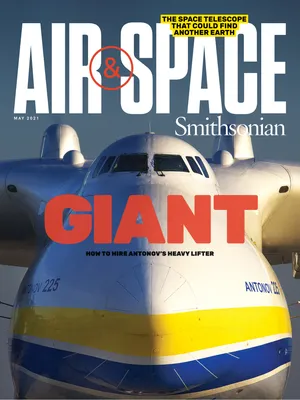The Airplane Changed Our Idea of the World
The invention of the airplane shook the globe, and it never looked the same again.
:focal(696x208:697x209)/https://tf-cmsv2-smithsonianmag-media.s3.amazonaws.com/filer/1e/f0/1ef02cd2-b4e9-42b0-be77-d73e125ba96a/12h_am2021_nicefrance_si-2001-11633_live.jpg)
The advent of human flight not only boosted our power of movement, but also enhanced our vision: We gained the ability to see the Earth from above. Before the Wrights’ epochal breakthrough, there had been perhaps thousands of human flights, mostly in balloons. But it was the advent of the airplane—a whole new way of seeing and experiencing our planet with speed and control—that led to euphoric reactions across the world. Wilbur and Orville caused the eruption with their first public flights in the summer and early fall of 1908.
In order to appreciate just how big the news was, it’s important to remember the widespread skepticism of the Wrights’ claims to have perfected a fully practical flying machine. They did not hide their machine during its development through 1905, but didn’t exactly invite crowds either. On February 10, 1906, the New York Herald put it bluntly: “The Wrights have flown or they have not flown. They possess a machine or they do not possess one. They are in fact either fliers or liars.”

But when they flew for the public—Wilbur first, on August 8, 1908, in Le Mans, France—the press reports were breathless: “I’ve seen him! I’ve seen them!” a reporter for Le Figaro cried. “There is no doubt! Wilbur and Orville Wright have well and truly flown!” Wilbur’s flights came on the heels of earlier French and American successes by other competitors: Henry Farman winning the Deutsch-Archdeacon prize for a one-kilometer circular flight; Glenn Curtiss winning the Scientific American Cup for a one-kilometer straight-line flight in his June Bug. But Wilbur’s flights in France, and then Orville’s at Fort Myer, Virginia, were longer and in greater control by far than anything that had come before. “WORLD’S AIR SHIP RECORD SMASHED BY ORVILLE WRIGHT AT FT. MYER, VA.,” blared the Washington Times on September 13 after he flew for more than an hour. An eyewitness was quoted as saying, “I would rather be Orville Wright right now than the President of the United States!”

When airplanes first flew, they brought two new astonishing experiences to the human race. One was simply the sight of a fellow human being traveling through the sky at speed and in control. Grand contests were held for the public to witness the miracle. The first such competition in the United States was at Dominguez Field in Los Angeles in January, 1910. “In Trial Flight [Glenn] Curtiss Soars Like Huge Bird. Thousands Cheer as New and Untried Biplane Leaps into the Sky,” announced the Los Angeles Herald. The meet ran for 10 days, and more than 250,000 people attended.
The second novel aspect of airplane flight was what the aviators and their passengers saw from the sky—experiencing our enhanced vision for the first time. Famed reporter Richard Harding Davis best describes the transformation. He went to Aiken, South Carolina to fly with Wright exhibition pilot and instructor Frank Coffyn in 1911. Although he’d covered the Johnstown Flood and the Spanish-American War, he approached Coffyn’s Wright Model B with terror. “I began to hate Coffyn and the Wright brothers,” he wrote. “I began to regret that I had not been brought up a family man so… I could explain that I could not go aloft because I had children to support. I was willing to support any number of children. Anybody’s children.”
But once they were in the air, “a wonderful thing happened,” he wrote. “The polo field and then the high board fence around it, and a tangle of telegraph wires, and the tops of the highest pine trees suddenly sank beneath us.... They fell so swiftly that in a moment the Whisky Road became a yellow ribbon, and the Iselin house and gardens a white ball on a green billiard cloth. We wheeled evenly in a sharp curve, and beyond us for miles saw cotton fields like a great chess board.”
He underwent an epiphany. “I began to understand why young men with apparently everything to make them happy on earth persist in leaving it by means of aeroplanes.... What lures them is the call of a new world waiting to be conquered, the sense of power, of detachment from everything humdrum, or even human, the thrill that makes all the other sensations stale and vapid, the exhilaration that for the moment makes each one of them a king.”
When they landed, Coffyn told Davis they’d flown about six miles. “But we had gone much farther than that,” wrote Davis. “And how much farther we still will go no man can tell.”
Wright Brothers & the Invention of the Aerial Age is made possible by the generous support of David M. Rubenstein and Frederick and Barbara Clark Telling.
